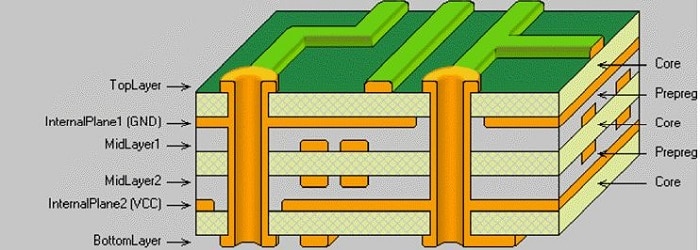Printed circuit boards are now the most important entity in electronics. PCBs used in the past were very simple and limited to a single layer. Today's PCBs are complex and are called multilayer PCBs. Those PCBs with limited functionality are single-layer, while those with multi-function PCBs are composed of multiple layers. Compact PCB for motherboards and more. Multilayer PCBs have now become a core component of complex electronic circuits.
What is a multilayer PCB?
A multilayer PCB can be defined as a PCB made with 2 or more foil conductive layers. The conductive foil appears to be various layers of a multi-sided circuit board. The different layers are laminated together and then bonded together, but thermally protected with an interlayer insulating layer. Place the layers in such a way that both sides of the PCB are on the surface. Vias are a source of electrical connections between different layers of a multilayer PCB. Due to the expansion of the electronics industry, people feel that 4-layer PCBs and higher-layer PCBs are needed. Over time, PCB issues such as noise, crosstalk, and stray capacitance have also been resolved, and PCBs don't have all of these issues these days. The best part is that the PCB now has a complex design and wonderful routing, which makes it attractive in electronic devices.
Advantages of Key 4 layer and higher PCB
Here are the key advantages of multilayer PCBs.
Small size: Small size makes these PCBs very important because the size of technology and electrical and electronic equipment is getting smaller and smaller. The layered design of the PCB provides smaller dimensions for electronics and electronic devices such as computers, smartphones, tablets, wearables, and laptops.
Frivolous Assembly: As mentioned above, 4-layer PCBs and higher PCBs are smaller, so these PCBs are good for contemporary gadgets.
Quality: A key characteristic of this type of PCB is its quality, because planning is in its creation. The results of these printed circuit boards are excellent, with no problems throughout their useful life.
Durability: Layer PCBs are durable because they can not only withstand huge weights, but also withstand high temperatures. There is always insulation between the different layers in these PCBs to provide protection from damage.
Flexible design: These PCBs now have flexible designs, but all multilayer PCBs are not flexible. If a slight bend is required, a flexible 4-layer PCB or higher PCB can be very useful. However, all of these PCBs are not flexible.
Power: These components of these PCBs have high density and are comprised of different layers made into a single layer PCB. These adjacent areas enable additional connection of circuit boards, and the electrical characteristics of these PCBs allow them to have more power.




